现在分词作状语有几种形式
- 格式:ppt
- 大小:580.50 KB
- 文档页数:23
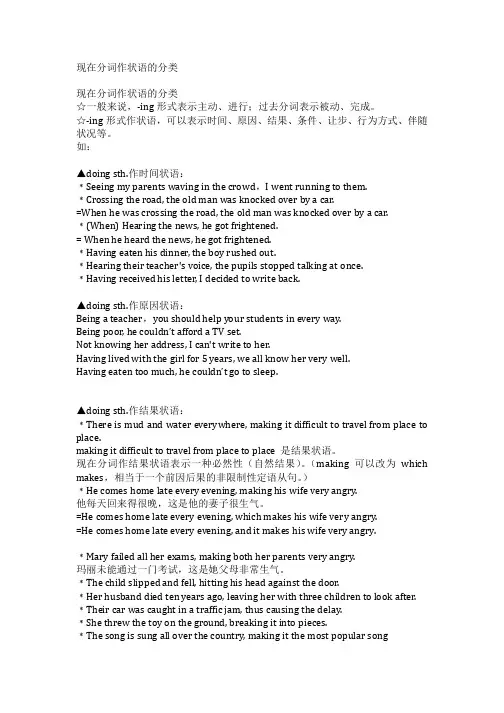
现在分词作状语的分类现在分词作状语的分类☆一般来说,-ing形式表示主动、进行;过去分词表示被动、完成。
☆-ing形式作状语,可以表示时间、原因、结果、条件、让步、行为方式、伴随状况等。
如:▲doing sth.作时间状语:﹡Seeing my parents waving in the crowd,I went running to them.﹡Crossing the road, the old man was knocked over by a car.=When he was crossing the road, the old man was knocked over by a car.﹡(When) Hearing the news, he got frightened.= When he heard the news, he got frightened.﹡Having eaten his dinner, the boy rushed out.﹡Hearing their teacher's voice, the pupils stopped talking at once.﹡Having received his letter, I decided to write back.▲doing sth.作原因状语:Being a teacher,you should help your students in every way.Being poor, he couldn’t afford a TV set.Not knowing her address, I can't write to her.Having lived with the girl for 5 years, we all know her very well.Having eaten too much, he couldn’t go to sleep.▲doing sth.作结果状语:﹡There is mud and water everywhere, making it difficult to travel from place to place.making it difficult to travel from place to place 是结果状语。

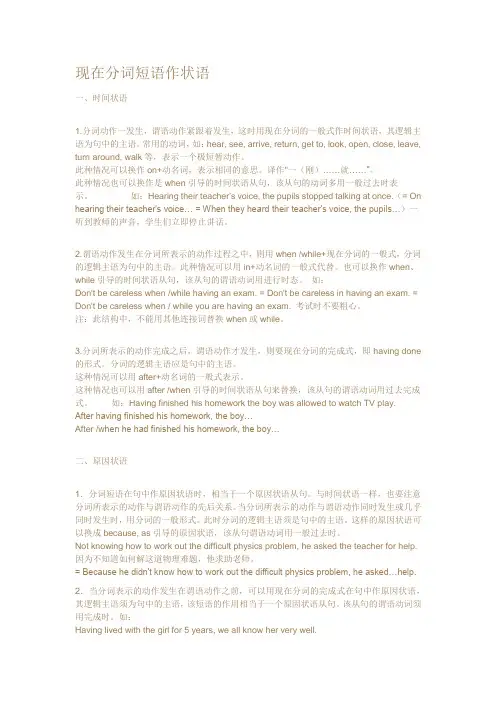
现在分词短语作状语一、时间状语1.分词动作一发生,谓语动作紧跟着发生,这时用现在分词的一般式作时间状语,其逻辑主语为句中的主语。
常用的动词,如:hear, see, arrive, return, get to, look, open, close, leave, turn around, walk等,表示一个极短暂动作。
此种情况可以换作on+动名词,表示相同的意思。
译作"一(刚)……就……"。
此种情况也可以换作是when引导的时间状语从句,该从句的动词多用一般过去时表示。
如:Hearing their teacher's voice, the pupils stopped talking at once.(= On hearing their teacher's voice… = When they heard their teacher's voice, the pupils…)一听到教师的声音,学生们立即停止讲话。
2.谓语动作发生在分词所表示的动作过程之中,则用when /while+现在分词的一般式,分词的逻辑主语为句中的主语。
此种情况可以用in+动名词的一般式代替。
也可以换作when、while引导的时间状语从句,该从句的谓语动词用进行时态。
如:Don't be careless when /while having an exam. = Don't be careless in having an exam. = Don't be careless when / while you are having an exam. 考试时不要粗心。
注:此结构中,不能用其他连接词替换when或while。
3.分词所表示的动作完成之后,谓语动作才发生,则要现在分词的完成式,即having done 的形式。
分词的逻辑主语应是句中的主语。
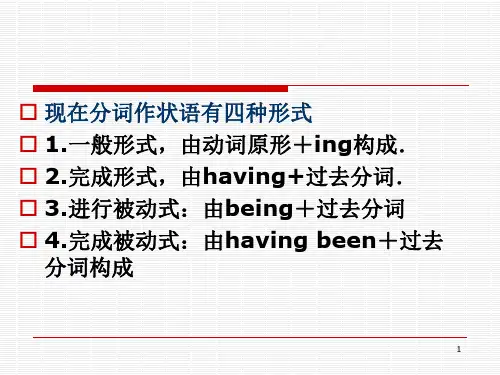
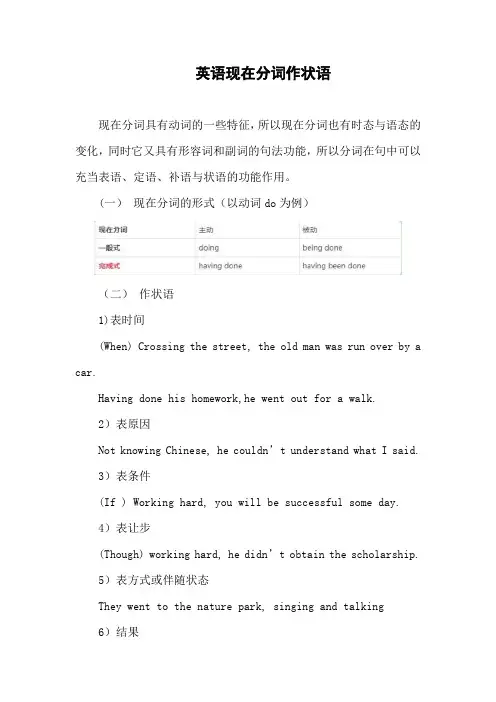
英语现在分词作状语现在分词具有动词的一些特征,所以现在分词也有时态与语态的变化,同时它又具有形容词和副词的句法功能,所以分词在句中可以充当表语、定语、补语与状语的功能作用。
(一)现在分词的形式(以动词do为例)(二)作状语1)表时间(When) Crossing the street, the old man was run over by a car.Having done his homework,he went out for a walk.2)表原因Not knowing Chinese, he couldn’t understand what I said.3)表条件(If ) Working hard, you will be successful some day.4)表让步(Though) working hard, he didn’t obtain the scholarship.5)表方式或伴随状态They went to the nature park, singing and talking6)结果The boy dropped the cup, breaking it into pieces.(三)与状语从句互换分词作状语当表时间、原因、条件、让步时可以与状语从句互换(分词作状语就相当于一个状语从句)1)表时间Crossing the street(=When the old man was crossing), the old man was run over by a car.Having done his homework(After he had done his homework ),he went out for a walk.2)表原因Not knowing Chinese(=Because he didn’t know Chinese ), he couldn’t understand what I said.3)表条件Working hard( If you work hard ), you will be successful some day.4)表让步Working hard (Though he worked hard) , he didn’t obtain the scholarship.5)表方式或伴随状态They went to the nature park, singing and talking (不好互换)6)表结果The boy dropped the cup, breaking it into pieces. (不好互换)注意问题:1.要熟练掌握现在分词的四种表达形式。

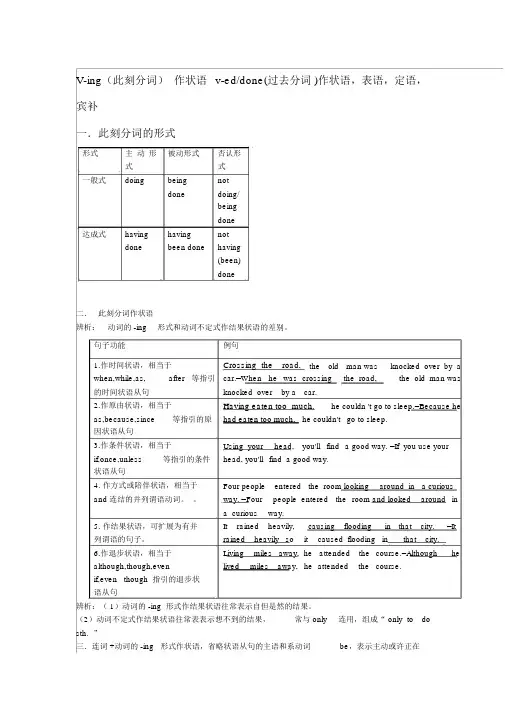
V-ing(此刻分词)作状语v-ed/done(过去分词 )作状语,表语,定语,宾补一.此刻分词的形式形式主动形被动形式否认形式式一般式doing being notdone doing/beingdone达成式having having notdone been done having(been)done二.此刻分词作状语辨析:动词的 -ing形式和动词不定式作结果状语的差别。
句子功能例句1.作时间状语,相当于Crossing the road,the old man was knocked over by awhen,while,as,after 等指引car.=When he was crossing the road,the old man was 的时间状语从句knocked over by a car.2.作原由状语,相当于Having eaten too much,he couldn 't go to sleep.=Because heas,because,since等指引的原had eaten too much,he couldn't go to sleep.因状语从句3.作条件状语,相当于Using your head,you'll find a good way. =If you use yourif,once,unless等指引的条件head, you'll find a good way.状语从句4. 作方式或陪伴状语,相当于Four people entered the room looking around in a curiousand 连结的并列谓语动词。
way. =Four people entered the room and looked around ina curious way.5. 作结果状语,可扩展为有并It rained heavily,causing flooding in that city.=It列谓语的句子。

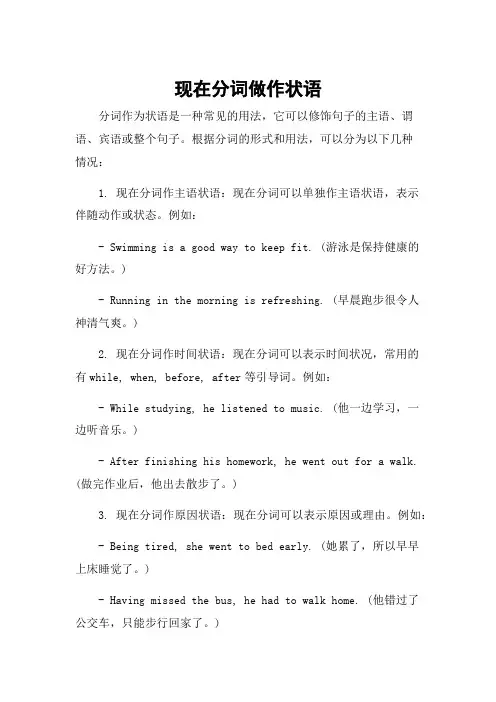
现在分词做作状语分词作为状语是一种常见的用法,它可以修饰句子的主语、谓语、宾语或整个句子。
根据分词的形式和用法,可以分为以下几种情况:1. 现在分词作主语状语:现在分词可以单独作主语状语,表示伴随动作或状态。
例如:- Swimming is a good way to keep fit. (游泳是保持健康的好方法。
)- Running in the morning is refreshing. (早晨跑步很令人神清气爽。
)2. 现在分词作时间状语:现在分词可以表示时间状况,常用的有while, when, before, after等引导词。
例如:- While studying, he listened to music. (他一边学习,一边听音乐。
)- After finishing his homework, he went out for a walk. (做完作业后,他出去散步了。
)3. 现在分词作原因状语:现在分词可以表示原因或理由。
例如:- Being tired, she went to bed early. (她累了,所以早早上床睡觉了。
)- Having missed the bus, he had to walk home. (他错过了公交车,只能步行回家了。
)4. 现在分词作结果状语:现在分词可以表示结果,常用的情况有so, therefore等引导词。
例如:- He studied hard so as to pass the exam. (他努力学习,以便通过考试。
)- The weather was bad, so they stayed at home. (天气不好,所以他们呆在家里。
)。
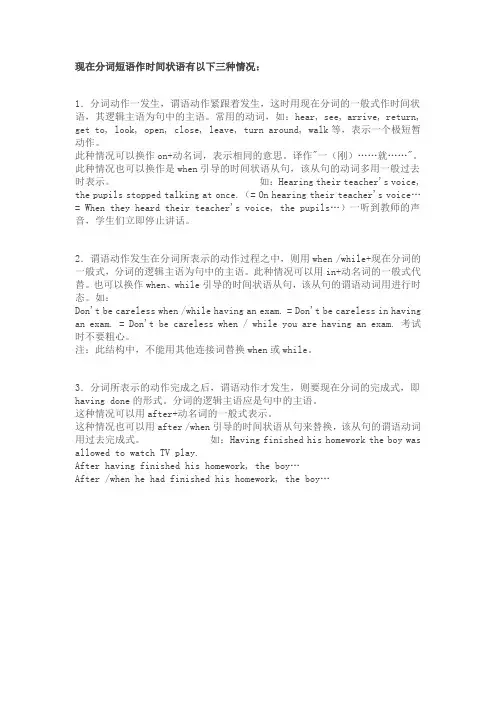
现在分词短语作时间状语有以下三种情况:1.分词动作一发生,谓语动作紧跟着发生,这时用现在分词的一般式作时间状语,其逻辑主语为句中的主语。
常用的动词,如:hear, see, arrive, return, get to, look, open, close, leave, turn around, walk等,表示一个极短暂动作。
此种情况可以换作on+动名词,表示相同的意思。
译作"一(刚)……就……"。
此种情况也可以换作是when引导的时间状语从句,该从句的动词多用一般过去时表示。
如:Hearing their teacher's voice, the pupils stopped talking at once.(= On hearing their teacher's voice… = When they heard their teacher's voice, the pupils…)一听到教师的声音,学生们立即停止讲话。
2.谓语动作发生在分词所表示的动作过程之中,则用when /while+现在分词的一般式,分词的逻辑主语为句中的主语。
此种情况可以用in+动名词的一般式代替。
也可以换作when、while引导的时间状语从句,该从句的谓语动词用进行时态。
如:Don't be careless when /while having an exam. = Don't be careless in having an exam. = Don't be careless when / while you are having an exam. 考试时不要粗心。
注:此结构中,不能用其他连接词替换when或while。
3.分词所表示的动作完成之后,谓语动作才发生,则要现在分词的完成式,即having done的形式。
分词的逻辑主语应是句中的主语。
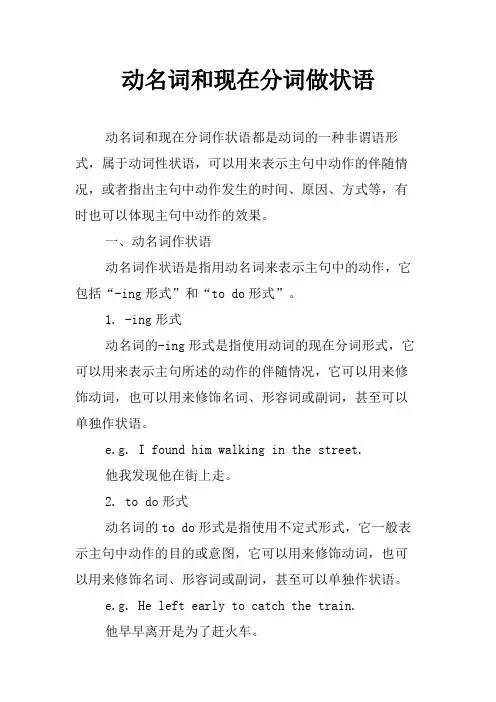
动名词和现在分词做状语动名词和现在分词作状语都是动词的一种非谓语形式,属于动词性状语,可以用来表示主句中动作的伴随情况,或者指出主句中动作发生的时间、原因、方式等,有时也可以体现主句中动作的效果。
一、动名词作状语动名词作状语是指用动名词来表示主句中的动作,它包括“-ing形式”和“to do形式”。
1. -ing形式动名词的-ing形式是指使用动词的现在分词形式,它可以用来表示主句所述的动作的伴随情况,它可以用来修饰动词,也可以用来修饰名词、形容词或副词,甚至可以单独作状语。
e.g. I found him walking in the street.他我发现他在街上走。
2. to do形式动名词的to do形式是指使用不定式形式,它一般表示主句中动作的目的或意图,它可以用来修饰动词,也可以用来修饰名词、形容词或副词,甚至可以单独作状语。
e.g. He left early to catch the train.他早早离开是为了赶火车。
二、现在分词作状语现在分词也可以作状语,它表示主句中的动作发生的时间、原因、方式等,有时也可以体现主句中动作的效果。
1. 表示时间现在分词常用来表示一个动作发生的时间,可以用来修饰动词,也可以用来修饰名词、形容词或副词,甚至可以单独作状语。
e.g. Arriving late, he found his seat occupied.他迟到了,发现自己的座位被占了。
2. 表示原因现在分词常用来表示一个动作发生的原因,它一般作为状语放在主句的前面。
e.g. Being sick, he stayed home.他因为生病,所以留在家中。
3. 表示方式现在分词常用来表示一个动作的方式,它一般作为状语放在主句的前面。
e.g. Taking a taxi, we got there in no time.我们坐出租车很快就到了。
4. 表示效果现在分词常用来表示一个动作的效果,它一般作为状语放在主句的前面。
现在分词作状语用现在分词作状语,其实多数情况下是现在分词和它的连带成分一起作状语,即现在分词短语作状语,相当于其相应的状语从句。
多数情况下置于句首,也可置于句末。
例:1.作时间状语Entering the classroom, the students began to read English.一进教室,学生们就开始读英语。
(相当于As soon as/After they entered the classroom)2.作原因状语The girl doesn't feel like eating any food, being ill for a few days.女孩不想吃任何食物,她病了好几天了。
(相当于Because she has been ill for a few days或Because of her being ill for a few days)3.作条件状语Working hard, he will succeed in passing the English examination.努力学习的话,他就可以通过英语考试。
(相当于从句If he works hard)4.作让步状语Being tired after work, he still insists on studying French.下班后很累,他任然坚持学习法语。
(相当于Though he is tired after work或Though tired after work)5.作结果状语People all over the world sing the song, making it popular.全世界的人都唱这首歌,使它流行了起来。
(相当于so that they make it popular)6.作方式状语Travelling by car , we enjoyed many beautifull places.乘车旅行,我们欣赏了很多优美地方。
用作状语的分词称为分词从句或分词短语,用于表示句子中与主动词同时发生或在主动词之后发生的动作。
以下是将分词用作状语的一些常见方法:
分词短语:分词短语是分词加上任何宾语、补语和/或修饰语。
例如,“在公园散步时,她看到了一只兔子”。
在这句话中,“walking in the park”是分词短语,作为状语修饰“she saw”。
现在分词:现在分词是由动词的基本形式加上“-ing”构成的。
例如,“工作到很晚,她半夜才回家”。
在这句话中,“Working late”是现在分词,作为状语修饰“she didn't get home until midnight”。
过去分词:过去分词通常通过在规则动词后加“-ed”或对不规则动词使用第二种形式来构成。
例如,“完成项目,他去度假了”。
在这句话中,“Finished with the project”是过去分词,作为状语修饰“he went on vacation”。
重要的是要记住,如果一个句子中有多个分词从句,分词从句应该相互平行,并且它们的时态也应该与句子的主句一致。
现在分词作状语现在分词作状语时, 分词的逻辑主语必须是句子的主语, 分词必须和句中的主语含有逻辑上的主谓关系, 否则不能用现在分词作状语。
但要注意它的各种形式变化:主动形式被动形式一般式V-ing being V-ed完成式having V-ed having been V-ede. g. Hearing the bell, the students began to enter the classroom.听见铃声, 学生们开始走进教室。
(听见和进入两个动作同时发生)The building being built now is our new library. 现在正在建造的这栋楼房室我们的新图书馆。
(being built为现在分词的被动形式, 表示动作正在进行之中)Having done the work, he went home. 完成了工作, 他就回家了。
现在分词在句中作状语, 修饰谓语动词或整个句子, 表示动作发生的原因、时间、方式、结果、条件、伴随状况等。
现在分词一般不用作表目的地状语(通常用不定式表目的地状语)。
1)表时间状语Walking in the street, I came across an old friend of mine.(=When I was walking in the street, I came across an old friend of mine.)While waiting for the bus, he read a copy of China Daily.(=While waiting for the bus, he read a copy of China Daily.)2) 表原因状语Being ill, he didn’t go to school.(=as he was ill, he didn’t go to school.)既然你是一个学生, 你就应该努力学习。
现在分词短语可以用作状语,修饰句子中由谓语表示的主要动作。
这个状语可以表示动作发生的时间、原因、结果、条件、方式或表示主要动作发生的伴随情况,通常相当于一个状语从句或并列分句。
一般说来,这种结构的逻辑主语就是句子的主语。
下面分述如下:一、作时间状语如果现在分词的动作和主谓语的动作同时发生,分词用一般式,有时其前可以加上连词while或when。
例如:①Hearing the news,they all jumped with joy.(=When they heard the news,they...)听到这个消息时,他们都高兴得跳了起来。
②Walking slowly across the grass,he pointed the gun at the lion and fired.他慢慢地走过草地,把枪对准狮子就射击了。
③One day,while walking along the sands towards his boat,Crusoe saw in the sand the mark of a man's foot.有一天,克鲁索沿着沙滩走向他的船时,在沙子里看见一个人的脚印。
如果现在分词的动作结束之后,谓语动词的动作才发生,现在分词应用完成式。
这时分词所表示的动作有一定的持续性。
如果用一般式就会给人感觉到似乎是"某人在做某事时就开始做某事",容易产生误解。
但是,如果现在分词是hear,see等表示感官的动词或是leave,arrive,turn,open等表示位置转换或情况改变的动词,现在分词所表示的动作发生后,主句的动作往往紧接着发生,那就不必用完成式,仍用一般式。
例如:①Having watered the flowers(=After/When he had watered the flowers),he began to cut the grass.他把花浇好后,开始割草。
现在分词作状语举例说明
分词作状语,是指分词(动词的现在分词形式或过去分词形式)在句中充当状语,修饰主句的谓语动词,表示时间、原因、条件、方式等等。
以下是一些例子:
1. 时间状语:Having finished my homework, I went out for a walk. (我做完作业后,出去散步了。
)
在这个句子中,动词分词短语“Having finished my homework”作时间状语,说明主句中的动作发生在前一个动作完成之后。
2. 原因状语:Being tired, she decided to go to bed early. (她因为累了,决定早点睡觉。
)
在这个句子中,动词分词短语“Being tired”作原因状语,解释了为什么她要早点睡觉。
3. 条件状语:If invited, I will attend the party. (如果被邀请,我会参加派对。
)
在这个句子中,动词过去分词短语“If invited”作条件状语,表示只有在被邀请的情况下,我才会去参加派对。
4. 方式状语:He drove to work, singing loudly all the way. (他一路上唱着大声的歌开车去上班。
)
在这个句子中,动词分词短语“singing loudly”作方式状语,说明他开车去上班的方式。
这些例子展示了分词作状语的不同用法。
需要注意的是,分词作状语时一般放在句子的前面或者后面,如果在句子的前面,要用逗号将其与主句分开。
现在分词作状语的七种用法
1. 表示时间,看呐,Walking in the park, I saw a beautiful flower.(当我在公园散步时,看到了一朵漂亮的花。
)
2. 表示原因,你想想,Being ill, he didn't go to school.(因为生病了,他没去上学。
)
3. 表示条件,要是,Working hard, you will succeed.(努力工作,你就会成功。
)
4. 表示伴随,哎呀,She sat there reading a book.(她坐在那儿读着一本书。
)
5. 表示方式,就像,He came running.(他跑着过来了。
)
6. 表示结果,哇塞,The cup fell on the ground, breaking into pieces.(杯子掉在地上,摔成了碎片。
)
7. 表示让步,即便,Knowing it's hard, he still tries.(尽管知道很难,他还是尝试。
)
这不就是现在分词作状语的七种用法嘛,很简单易懂吧!多有意思呀是不是!。